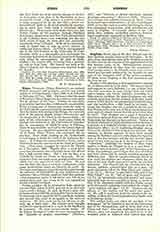

Steno, NICOLAUS (NIELS STEENSEN), an eminent Danish anatomist and geologist, convert and saintly bishop, b. at Copenhagen, January 1, 1638; d. at Schwerin in Germany, November 25, 1686. For many years the name of Steno was almost forgotten; in science he was centuries in advance of his time. During the last thirty years justice has been done to his merits as a scientist. When a young man of twenty-two years he went to the Netherlands to proceed with his anatomic studies; there he discovered, among other things, the excretory duct of the parotid glands (ductus Stenonianus) and the circulation of the blood in the human body. In spite of his achievements his countrymen failed to appoint him professor at the University of Copenhagen, in consequence of which he went to Florence, where he was cordially received by the Grand Duke of Tuscany. He was appointed anatomist at the Hospital of Santa Maria Nuova and continued his researches. Even while residing in the Netherlands he had begun to doubt the truth of the Lutheran doctrines. At Cologne he conferred with a Jesuit, and at Florence he became convinced of the truth of Catholicism. After many struggles he entered the Church on November 4, 1667. Shortly after a royal letter came from Denmark, that called him home and offered him a high annual salary. But it was too late; as a Catholic he could not return to Denmark. He remained in Italy and made many geological discoveries, which were not appreciated until our time. He was also the first who gave a scientific explanation of the many petrifactions which are found in the earth. In Denmark men began to regret Steno’s loss, and through the influence of Griffenfeldt he was nominated, not professor—for a Catholic could not hold that position—but anatomicus regius in his native city, but he remained there only two years, as he was exposed to narrow-minded treatment.
Feeling a higher call, he returned to Italy, where he received Holy orders in 1675, and two years after was consecrated a bishop. As such, he lived a most self-denying and mortified life, giving all he had to the poor. He was made vicar Apostolic for the northern missions and worked nine years as an apostle in the north of Germany. He died, worn out by his labors, at the early age of forty-eight. His remains were brought to Florence and deposited in a vault in the Basilica of St. Lawrence. He wrote several ascetic works. Of his sixteen theological works the more interesting are his “Epistola de propria conversione” (Florence, 1677), and “Defensio et plenior elucidatio epistolae de propria conversione” (Hanover, 1680). His scientific writings were published recently by Maar, “Nicolai Stenonis opera philosophica” (2 vols., Copenhagen, 1910), a very fine work in quarto, containing his thirty-two anatomical dissertations, with introduction and notes in English. A facsimile edition of his “De solido intra solidum naturaliter contento dissertationis prodromus” appeared at Berlin in 1904.
NIELS HANSEN

